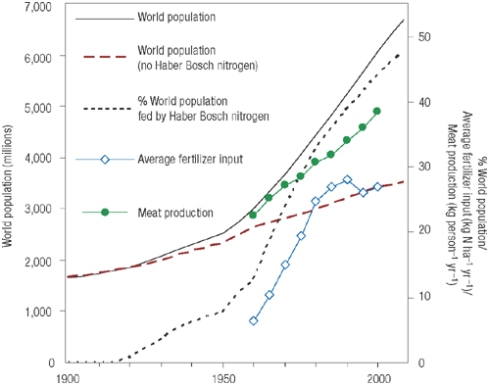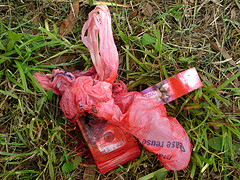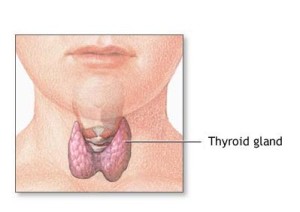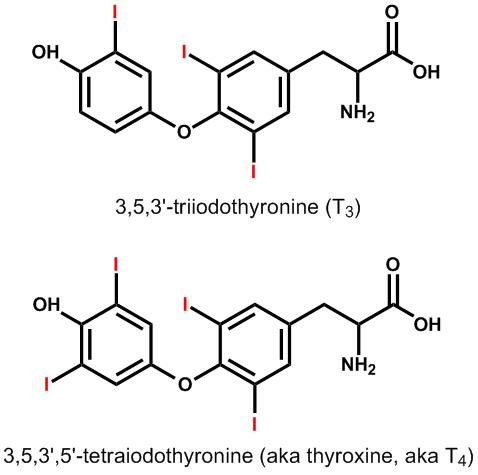UPDATE: June 3, 2020
I wrote this post over nine years ago. It’s been bothering me ever since. I want to apologize for it.
In this post, I talked about the Haber-Bosch process while not talking about Fritz Haber himself, and the devastation he let loose upon the world, and on Jewish people in particular.
Haber was a patriotic German Jew in the early 1900s. His work on the synthesis of ammonia gave Germany a ready supply of the compound during the World War I, something they previously didn’t have. Ammonia can be easily converted into nitrates, which are used to make both fertilizer and explosives. Without Haber’s work, historians say that Germany would have had to end the war earlier, because they would have run out of explosives. An earlier exit from the war might have meant that Hitler would not have come to power, and the Holocaust might not have happened. Without it, millions and millions of Jewish people, as well as Soviet, Roma, and Slavic people, people with disabilities, homosexuals, and Nazi political and idealogical opponents, may have not been murdered. Haber also worked on chemical warfare agents that killed thousands of soldiers in WWI. His discoveries contributed to the development of Zyklon B poison gas, which was later used to slaughter Jews and others in concentration camps.
I referred to Haber’s life tangentially in this post, but left the discussion to articles and a book I linked to, and didn’t address it myself. This was cowardly and shitty and wrong. I’m really sorry about this. An editor, who later became a friend, alluded to this glaring omission when I first posted this, but it went over my head at the time that I was seemingly glorifying Fritz Haber. The older I get, the more oblivious I realize I am.
There are no words that can encompass the horrors that Haber’s discoveries contributed to, and fed. I have a habit of thinking that certain things are obvious, and so I don’t need to mention them. I should have talked about this in an obvious and upfront way, instead of just adding a sentence in parentheses near the bottom of the post, linking to people who confront it, and who are braver than I am. I am an educated white woman, raised catholic, and come from a financially stable family. I’ve never been part of any racial, ethnic, or religious minority. I may have been personally broke at times, but I’ve always had a family cushion to fall back on. My enormous privilege caused me to leave out Haber’s abhorrent, horrendous, and detestable actions, and thinking that I didn’t need to say what other people already had, that it was abhorrent, horrendous, and detestable. I did need to say it. I do need to say it. I apologize so deeply to everyone, especially people who are marginalized and oppressed, and to Jewish people in particular. It was out of line and not ok that I left this out.
Fritz Haber’s chemistry made the world a worse place. Some people debate whether Haber was a great scientist. He was not. There’s no question of that. The contributions he made to science are never going to be anywhere close to worth the lives he caused to be lost.
I’m leaving this post up. I haven’t changed anything. I feel that altering it in any way would further hide my mistake. I don’t want to be silent again.
~~~~~~~~~~~~~~~~~~~~~~~~~~~~~~~~~~~~~~~~~~~~~~~~~~~~~~~~~~~~~
What’s the most important scientific discovery ever?
I put this question up on facebook, and people came up with some pretty good answers. Electricity was the most popular. Fermentation and antibiotics were also good suggestions. But when you think it in terms of having a direct impact on the largest amount of people, there’s really only one answer: the Haber-Bosch process.
Yeah, I know. You’ve never heard of it. But you may be alive because of it.
The Haber-Bosch process is how you make ammonia out of nitrogen and hydrogen gasses. I’m simplifying it a wee bit, but here’s how it works:
You take your hydrogen and nitrogen,

squish the crap out of them and make them really really hot,

and poof! You have ammonia!

The thing about this process–chemists had been trying to do this for more than 100 years when Fritz Haber figured it out in 1909. As living things, nitrogen’s pretty important to us. Our bodies are about three percent nitrogen by weight, and we get it from eating plants and other animals. But plants, having no mouths (for the most part), have to get it either from the air or the soil. The problem is that even though N2 (the nitrogen molecule, Fig. 1) makes up almost 80% of the air we breathe, it doesn’t react with anything. That triple bond you see up there is quite strong, and it takes a lot of energy to pull it apart, more than plants generally have at their disposal. So plants can’t break it down1 and recycle it into things like amino acids and cell walls and all that useful stuff. For it to be usable, nitrogen has to be “fixed.”
Ammonia, NH3 (Fig. 3), is a fixed form of nitrogen. That means that its bonds are breakable, and it can react with other things. Generally, it’s used to make nitrates, NO3, which is used for both explosives and fertilizer. Natural forms of fixed nitrogen are rare, but it’s found in bat and bird poo, and saltpeter. These things were some seriously in demand fertilizers before the Haber-Bosch process was discovered. In fact, The Guano Islands Act of 1856 was passed so people could claim any uninhabited, poop-covered island they found as a US protectorate. Wars were fought over poo. Really. So when Haber found a way to finally make fixed nitrogen, it was quite a big deal.

Then Carl Bosch and Alwin Mittasch came along and figured out how to make Haber’s system workable on an industrial scale. Haber had originally used an osmium catalyst to make ammonia, but that’s pretty expensive. Mittasch went through about 4000 other catalysts until he found one that worked as well—a mixture of iron and metal oxides. The Haber-Bosch process was officially rolled out in the industrial world in 1913. Haber won the Nobel Prize for it in 1918. Bosch shared the prize with Friedrich Bergius in 1931 for figuring out how to deal with high-pressure chemistry.
So this was a great chemical breakthrough and all that, but the really important thing? A lot of people stopped starving to death.

Figure 5. Effect of the Haber-Bosch process on world population. Graph from Erisman, J. W.; Sutton, M. A.; Galloway, J.; Klimont, Z.; Winiwarter, W. “How a Century of Ammonia Synthesis Changed the World”. Nat. Geosci. 2008, 1: 636-630.
The above graph shows how the world’s population changed after we got cheap, available fertilizer. Look at the difference between the solid black line and the dashed red line. According to this chart, about 3 billion people are alive today because of this. Because of one chemical reaction.
The Haber-Bosch process is used to make about 500 million tons of artificial fertilizer per year, and sustains about 40% of the population. It uses about ONE PERCENT of the world’s total energy supply2. If the population continues to grow as expected, then by 2050, about 270 million tons of coal (or equivalent energy) will be needed to make enough fertilizer to keep us all from starving to death.3
One chemical reaction.
On the flip side, nitrogen runoff from fertilizer is choking lakes and rivers with algae and messing up the ecosystem. Keeping the Haber-Bosch reaction running is filling the air with carbon dioxide, carbon monoxide, and other combustion byproducts that are changing the climate. I’m not even going to go into the potential impact of a hugegrowingwayfast population. (Tangentially, Haber’s discovery also kept the Germans in explosives during World War I. He’s known as the father of chemical warfare, and his work led to the use of Zyklon B in Nazi death camps.The Alchemy of Air is a fascinating book about the whole history. The writing is a bit dry, but I still highly recommend.)
Even taking these things into account, it cannot be argued that the Haber-Bosch process has had an ungodly huge impact on all of our lives. Go ahead, try to deny it. Try with both hands.
This year is the International Year of Chemistry, “celebrating the achievements of chemistry and its contributions to the well-being of mankind.” And believe it or not, there are a lot of them. Way too many to mention. Way too many for us to even know about.
Chemistry: this shit’s important.
…………………………………………
For more reading on the Haber-Bosch process, I suggest of The Alchemy of Air, In the shadows of greatness, Jürgen Schmidhuber’s page on Haber and Bosch, and World Population: How Did It Get So Big?
1Legumes (eg beans or peanuts) have bacteria at the base of their roots called rhizobia that can pull nitrogen out of the air. They’re the only kind of plants that do this, and that’s why you’ll often see soybeans as a rotator crop with corn. Beans put nitrogen in the soil, and corn pulls quite a bit of it out.
2Science 297(1654), Sep 2002.
3Biological Nitrogen Fixation – National Research Council . National Academic Press 1994.


















